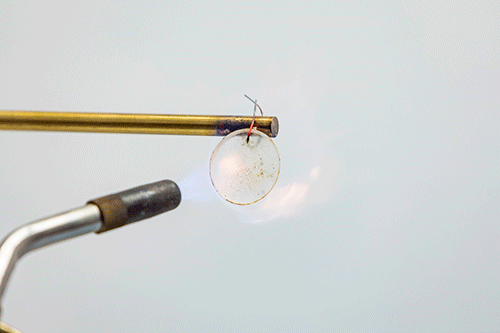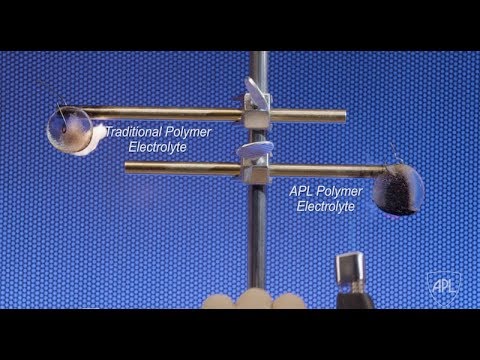Press Release
Johns Hopkins APL’s Breakthrough Flexible, Cuttable Lithium-Ion Battery Now Won’t Catch Fire
The Unbreakable Battery That Already Operated Under Extreme Conditions Now Adds Unprecedented Safety Capabilities

Credit: Johns Hopkins APL
A team of researchers from the Johns Hopkins Applied Physics Laboratory (APL) in Laurel, Maryland, has realized another landmark achievement with their breakthrough lithium-ion battery technology.
The flexible Li-ion battery that can operate under extreme conditions — including cutting, submersion and simulated ballistic impact — can now also add incombustible to its resume.
Relying on flammable and combustible materials, current Li-ion batteries (LIBs) are susceptible to catastrophic fire and explosion incidents — most of which arrive without any discernable warning. Notably, Samsung Galaxy7 phones were banned from airlines because of this danger, and the Navy’s prohibition of e-cigarettes on ships and submarines is a direct response to the obvious need to reduce the flammability of the power source of choice for portable electronics, electric vehicles and more.
In research published recently in the journal Chemical Communications, of the Royal Society of Chemistry, the team updates its latest discovery: a new class of “water-in-salt” (WiS) and “water-in-bisalt” (WiBS) electrolytes incorporated in a polymer matrix that reduces water activity and elevates the battery’s energy capabilities and life cycle — while ridding it of the flammable, toxic and highly reactive solvents present in current Li-ion batteries.
It’s a safe, powerful alternative.
Led by Konstantinos Gerasopoulos of APL’s Research and Exploratory Development Department (REDD), the team also includes lead author Spencer Langevin, Bing Tan, Adam Freeman, Jarod Gagnon, Christopher Hoffman Jr., Matthew Logan and Jeff Maranchi (all of REDD).
The team’s latest work significantly advances the state of the art in aqueous LIBs and forms the foundation for the next generation of battery technology. With LIBs emerging as the energy storage vehicle of choice for portable electronics, electric vehicles and grid storage, the safety advancements mark a significant step forward, transforming the way Li-ion batteries are manufactured and used in electronic devices.
“Li-ion batteries are already a constant presence in our daily lives, from our phones to our cars, and continuing to improve their safety is paramount to further advancing energy storage technology,” said Gerasopoulos, senior research scientist and principal investigator at APL. “Li-ion battery form factors have not changed much since their commercialization in the early 1990s; we still use the same cylindrical or prismatic cell types. The liquid electrolyte and required hermetic packaging have a lot to do with that.
“Our team’s efforts have generally been focused on replacing the flammable liquid with a polymer that improves safety and form factor. We are excited about where we are today. Our recent paper shows improved usability and performance of water-based flexible polymer Li-ion batteries that can be built and operated in open air.”
In this new research, the team overcame the restrictions of liquid WiBS electrolytes — which are inherently safe due to the presence of water but limit energy capability and are not compatible with most commercially used anode materials. They did so through the development of “stable WiBS-based aqueous gel polymer electrolytes (GPEs) made via UV-mediated polymerization of water-soluble acrylates in the presence of WiBS,” the authors wrote.
The scientists were able to demonstrate that a UV curing process and the integration of WiBS in a polymer improved retention of free water as it is coordinated by the polymer, leading to an expanded electrochemical stability window. “For the first time, we show that Li4Ti5O12 (LTO), a low-cost and widely used anode in today’s market, can be reliably used for greater than 100 cycles in an aqueous polymer LIB full cell,” the authors wrote.
Additionally, the damage tolerance demonstrated with the breakthrough flexible battery in 2017 is further improved by the new polymer electrolyte.
“The first generation of flexible batteries were not as dimensionally stable as those we are making today,” Gerasopoulos said. “Our UV-cured polymer is a freestanding, mechanically robust film, akin to a contact lens. These batteries are completely exposed to air and continue to work for several days. We can burn them, cut them and stress them in other ways, and they still operate.
“With these new developments — improving the mechanical and electrochemical stability of the GPEs — we feel we’ve made significant advancements toward transitioning this new class of supersaturated aqueous gel polymer electrolytes from proof of concept to practical applications.”
With this latest benchmark reached, the researchers have already turned their eyes toward what’s next and continue to work on further advancements of this technology.
“Our team is continuously improving the safety and performance of flexible Li-ion batteries,” said Jeff Maranchi, the program area manager for materials science at APL. “We have already achieved further discoveries building upon this most-recently reported work that we are very excited about. We hope to transition this new research to prototyping within the year.”
